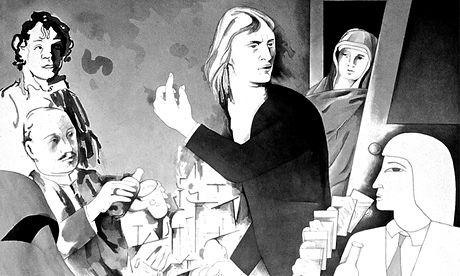
Work from Richard Hamilton's unfulfilled quest to create the definitive illustrations for James Joyce's novel Ulysses have gone on display at the British Museum. The 60 drawings and prints have been accepted by the government in lieu of almost £1m in taxes, due on the artist's estate since his death in 2011.
The father of pop art in Britain was celebrated in a major retrospective at Tate Modern this year. For his entire working life Hamilton loved Joyce's huge meandering tale of a day and night's wandering through the streets of Dublin, and he was also very interested in Irish politics and culture.
Ulysses was first published in Paris in 1922, the year of Hamilton's birth, and the artist first read the book in 1947 at a particularly difficult point in his life, having been forced into national service after being expelled from the Royal Academy art school for not obeying instructions. The following year he won a place at Slade, and produced his first illustrations for Ulysses, the first of scores of etchings and drawings created over the following decades.
The British Museum in London exhibited many of the Ulysses etchings in 2002, and afterwards Hamilton donated eight to the collection. The new acquisition adds more than 90 works including his first attempts at tackling the book.
A selection is going on display, free, at the museum in time for Bloomsday on 16 June, a date celebrated all over the world by fellow lovers of the book.
Stephen Coppel, assistant keeper of prints and drawing at the museum, who curated the 2002 exhibition, said Hamilton's ambition to illustrate the book was an unrealised odyssey.
"Although Hamilton continued to think and work on Joyce all his life, he never fulfilled his original ambition of illustrating all 18 episodes of Joyce's encyclopaedic text, and, like William Blake's illustrations to Dante's Divine Comedy, it remains one of the great unfinished projects. Hamilton always wanted the studies and prints of his lifelong odyssey into Joyce kept together and it is most gratifying that the entire group now finds a permanent home in the British Museum."
The exhibition includes Hamilton's view from above of the protagonist Leopold Bloom luxuriating in his bath. In the book, having bought his bar of lemon scented soap – still sold by the shop in Dublin now occupying the pharmacy Joyce knew – Bloom envisages the joy of the Turkish bath house which was once an exotic feature of Dublin life: "He foresaw his pale body reclined in it at full, naked, in a womb of warmth, oiled by scented melting soap, softly laved. He saw his trunk and limbs riprippled over and sustained, buoyed lightly upward, lemonyyellow: his navel, bud of flesh: and saw the dark tangled curls of his bush floating, floating hair of the stream around the limp father of thousands, a languid floating flower."
Peter Bazalgette, chair of Arts Council England, which administers the acceptance in lieu scheme (AIL), said: "The importance of these works cannot be underestimated. Richard Hamilton has proven to be one of the most significant British artists of the latter half of the 20th century, with two major exhibitions of his work taking place this year alone. The Arts Council is proud that the AIL scheme has contributed to this amazing collection entering the British Museum where it can now be enjoyed by literally thousands of visitors."
• Richard Hamilton's Ulysses collection is on display in room 90 of the British Museum, free

